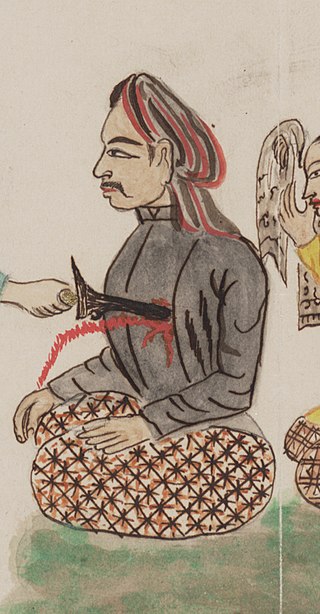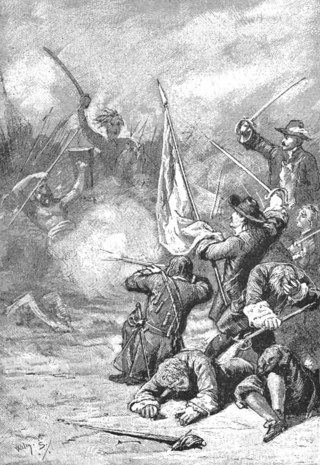
The Sultanate of Mataram was the last major independent Javanese kingdom on the island of Java before it was colonised by the Dutch. It was the dominant political force radiating from the interior of Central Java from the late 16th century until the beginning of the 18th century.

Sultan Agung Adi Prabu Anyakrakusuma, commonly known as Sultan Agung, was the third Sultan of Mataram in Central Java ruling from 1613 to 1645. He was a skilled soldier who conquered neighbouring states and expanded and consolidated his kingdom to its greatest territorial and military power.

Amangkurat I was the susuhunan of the Mataram Sultanate from 1646 to 1677.

Amangkurat II was the susuhunan of the Sultanate of Mataram from 1677 to 1703. Before taking the throne, he was the crown prince and had the title Pangeran Adipati Anom.

Untung Suropati also Untung Surapati was a warfighter in the East Indies who led a few rebellions against the Dutch East India Company (VOC). Some of his exploits were written in Babad Tanah Jawi.
The First Javanese War of Succession was a struggle between Sultan Amangkurat III of Mataram and the Dutch East India Company who supported the claim of the Sultan's uncle, Pangeran Puger to the throne.
The Second Javanese War of Succession was a struggle between Sultan Amangkurat IV of Mataram supported by the Dutch East India Company against the rebellion of rival Princes who contested his right for the throne.

Trunajaya (Madurese) or Tronajâyâ, also known as Panembahan Maduretno, was a prince and warlord from Arosbaya, Bangkalan, Madura, known for leading the Trunajaya rebellion (1674–1681) against the rulers of the Mataram Sultanate on the island of Java.
Pakubuwono I, uncle of Amangkurat III of Mataram was a combatant for the succession of the Mataram dynasty, both as a co-belligerent during the Trunajaya rebellion, and the First Javanese War of Succession (1704–1707).

The Mataram conquest of Surabaya or Mataram-Surabaya War was a military campaign by the Sultanate of Mataram in the early 17th century that resulted in the capture of the Duchy of Surabaya and its allies in eastern Java, in modern-day Indonesia. Prior to this conquest, Mataram and Surabaya were rivals for power in central and eastern Java. The campaign began in 1614 when Mataram, under the leadership of Sultan Agung, attacked Surabaya's allies, including Wirasaba. Surabaya and its allies launched a counterattack but were defeated near Pajang in 1616. Over the next few years, Mataram gradually conquered members of the Surabayan alliance, and by 1620, the city of Surabaya itself was under siege, holding out until it surrendered in 1625. With this conquest, Mataram unified most of central and eastern Java under its control, and cemented its position as the dominant power in Java. Surabaya and other conquered areas would remain in Mataram's hands until it was ceded to the Dutch East India Company in 1743.
The Duchy of Surabaya was a Javanese principality centered in Surabaya, on the northeastern coast of Java, that existed as an independent polity from c. 1546 to 1625. It became independent following the disintegration of the Demak Sultanate, and by the beginning of the 17th century had become the leading power in east Java and the most important port on Java's northeastern coast. Subsequently, it entered into decades of conflict with the Mataram Sultanate that ended in the victory of Mataram and the fall of Surabaya in 1625.

The Trunajaya Rebellion or Trunajaya War was the ultimately unsuccessful rebellion waged during the 1670s by the Madurese prince Trunajaya and fighters from Makassar against the Mataram Sultanate and its Dutch East India Company (VOC) supporters in Java.

The Fall of Plered was the capture of the capital of the Mataram Sultanate by the rebel forces loyal to Trunajaya in late June 1677. The attack on Plered followed a series of rebel victories, notably in the Battle of Gegodog and the fall of most of Mataram's northern coast. The aged and sick King Amangkurat I and his sons offered an ineffective defense, and the rebels overran the capital on or around 28 June. The capital was plundered and its wealth taken to the rebel capital in Kediri. The loss of the capital led to the collapse of the Mataram government and the flight of the royal family. The king fled with his son the crown prince and a small retinue to Tegal and died there, passing the kingship to the crown prince, now titled Amangkurat II, without any army or treasury.
The Battle of Gegodog took place on 13 October 1676 during the Trunajaya rebellion, and resulted in the victory of the rebel forces over the Mataram army led by the Crown Prince Pangeran Adipati Anom. Gegodog is located on the northeastern coast of Java, east of Tuban.
After his victory at the Battle of Gegodog in northeast Java, the Madurese rebel leader Trunajaya proceeded westwards to conquer Mataram Sultanate's remaining towns on the north coast of Java. By January 1677, nearly all coastal towns from Surabaya to Cirebon were taken.
Pangeran Pekik was a Javanese prince, and son of the last Duke of Surabaya, Jayalengkara. After the Mataram conquest of Surabaya, he was forced to live in Mataram court. He was executed in 1659 on the orders of Mataram's King Amangkurat I, who suspected him of conspiracy.
Raden Kajoran, also Panembahan Rama was a Javanese Muslim nobleman and a major leader of the Trunajaya rebellion against the Mataram Sultanate. He led the rebel forces which overran and sacked Plered, Mataram's capital in June 1677. In September 1679, his forces were defeated by the combined Dutch, Javanese, and Bugis forces under Sindu Reja and Jan Albert Sloot in a battle in Mlambang, near Pajang. Kajoran surrendered but was executed under Sloot's orders.
I Maninrori Kare Tojeng, also known as Karaeng Galesong, was a Makassarese nobleman and warrior, and a major leader of the Trunajaya rebellion in Java against the Mataram Sultanate. He participated in the successful invasion of East Java and the subsequent rebel victory at Battle of Gegodog (1676). He later fell out with Trunajaya, and built a stronghold in Kakaper, East Java. Dutch East India Company (VOC) and Bugis forces took Kakaper in October 1679, but Galesong escaped and rejoined Trunajaya. He died on 21 November 1679, either by illness or murdered by Trunajaya, before the rebellion ended.

In a campaign that took place from August to December 1678 in Kediri during the Trunajaya rebellion, the forces of the Mataram Sultanate, led by Amangkurat II, and of the Dutch East India Company (VOC), led by Anthonio Hurdt, marched inland into eastern Java against Trunajaya's forces. After a series of marches beset by logistical difficulties and harassment by Trunajaya's forces, the Mataram–VOC army crossed the Brantas River on the night of 16–17 November. They then marched on Trunajaya's capital and stronghold at Kediri and took it by direct assault on 25 November. Kediri was plundered by the Dutch and Javanese victors, and the Mataram treasury—captured by Trunajaya after his victory at Plered—was completely lost in the looting. Trunajaya himself fled Kediri and continued his greatly weakened rebellion until his capture at the end of 1679.
Anthonio Hurdt was a Dutch East India Company (VOC) officer active in what is now Indonesia in the seventeenth century. He was initially assigned in civilian positions in Eastern Indonesia, the latest of which was the VOC Governor of Ambon. He was then posted to Java—in Western Indonesia—to lead the Kediri campaign against Trunajaya. After a protracted march slowed by logistical challenges, VOC and its ally Mataram overran Trunajaya and took his stronghold and court at Kediri, 25 November 1678. After the campaign he served in Batavia, becoming Director-General of the VOC in the Indies from 1684 to 1687, when he was expelled due to a dispute with Governor-General Joannes Camphuys.












